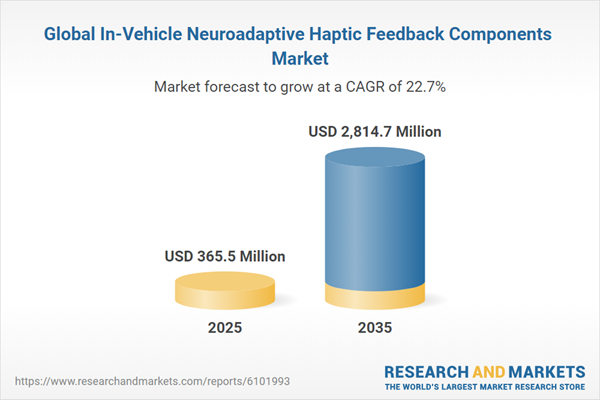This report comes with 10% free customization, enabling you to add data that meets your specific business needs.
In-vehicle neuroadaptive haptic feedback components market demand accelerators begin with the rapid replacement of mechanical switches by large glass cockpits and pillar-to-pillar displays, eliminating traditional tactile affordances and forcing OEMs to recreate “eyes-free” feedback. Regulators in the EU and North America are simultaneously tightening driver-distraction guidelines, prompting Tier-1 suppliers to integrate adaptive haptics as a compliance tool rather than a luxury add-on. Insurance data linking vibrotactile lane-departure alerts to crash-avoidance KPIs further strengthens the business case, making safety-driven ROI quantifiable for fleet buyers and retail consumers alike. Meanwhile, the push toward minimalistic interior styling in EVs deprioritizes physical controls, leaving neuroadaptive haptics as one of the few remaining channels for sensory confirmation. This convergence of regulatory pressure, safety economics, and design trends forms the first pillar of sustained in-vehicle neuroadaptive haptic feedback components market growth.
The second growth pillar of the in-vehicle neuroadaptive haptic feedback components market is technological maturation and cost curve of core components. Multilayer piezo stacks, once limited to high-end consumer electronics, now hit automotive production part approval process (PPAP) cost targets thanks to economies of scale in smartphone and wearables supply chains. Automotive-grade haptic drivers with closed-loop sensing eliminate latency and temperature drift, enabling consistent tactile signatures across seating, steering, and display modules. In parallel, cabin domain controllers powered by zonal E/E architectures provide the processing headroom to run real-time machine-learning models that personalize feedback intensity based on driver state or even circadian rhythm. Cloud-delivered “haptics-as-a-service” libraries - similar to OTA audio codecs - allow OEMs to refresh tactile effects post-sale, creating new subscription revenue streams and raising the lifetime value of the vehicle. All this expected to drive the growth of the in-vehicle neuroadaptive haptic feedback components market.
Strategic opportunities are emerging across the value chain. Seat system integrators can bundle neuroadaptive haptics with wellness analytics, targeting ride-hail and robo-taxi fleets looking to differentiate on comfort and safety. Display manufacturers are embedding surface haptics directly into cover glass, allowing Tier-2 suppliers to move up the stack and capture higher margins. For OEMs, neuroadaptive haptics can serve as a premium differentiator that justifies higher trim prices or subscription fees, especially as infotainment and ADAS features converge. Aftermarket players also see potential in retrofit kits for existing EV models, tapping into enthusiast communities that value tactile customizations. Collectively, these factors position the in-vehicle neuroadaptive haptic feedback components market for double-digit CAGR through the late-decade model cycles.
Market Lifecycle Stage
The global in-vehicle neuroadaptive haptic feedback components market is currently in the development and early adoption stage of its lifecycle. Driven by advancements in infotainment technology, increasing demand for efficient cost-effective solutions along with development of autonomous vehicles, this market is expanding rapidly. Innovations in haptic feedback systems and stringent vehicle safety regulations expected to drive the in-vehicle neuroadaptive haptic feedback components market demand.Global In-Vehicle Neuroadaptive Haptic Feedback Components Market Segmentation:
Segmentation 1: by Vehicle Type
- Passenger Vehicles
- Commercial Vehicles
- Light Commercial Vehicles
- Heavy Commercial Vehicles
Segmentation 2: by Propulsion Type
- Internal Combustion Engine (ICE) Vehicles
- Electric Vehicles (EV)
Segmentation 3: by Level of Autonomy
- Semi-Autonomous Vehicles
- Fully Autonomous Vehicles
Segmentation 4: by Component
- Haptic Actuators
- Neuroadaptive Sensors
- Control Electronics
- Others (Software, HMI)
Segmentation 5: by Product Type
- Touchscreen Haptics
- Steering Wheel Feedback System
- Others (Seat-based Modules, Pedal/Gear Feedback, etc.)
Segmentation 6: by Region
- North America - U.S., Canada, and Mexico
- Europe - Germany, France, U.K., Italy, Spain, and Rest-of-Europe
- Asia-Pacific - China, Japan, South Korea, India, and Rest-of-Asia-Pacific
- Rest-of-the-World - South America and Middle East and Africa
Key Market Players and Competition Synopsis
The global in-vehicle neuroadaptive haptic feedback components market is at initial phase of adoption with presence key players including Robert Bosch GmbH, Continental AG, Immersion Corporation, Harman Automotive, ZF Friedrichshafen, and Ultraleap among others. These companies are early developers through advanced manufacturing techniques, extensive research and development, and strategic partnerships with automakers. Emerging players are focusing on sustainable and cost-effective solutions to meet the growing demand for high-performance haptic feedback systems in both traditional and electric vehicles. The market is characterized by intense competition driven by technological advancements, regulatory compliance, and increasing vehicle production, leading to rapid innovation and collaboration across the automotive value chain.Some of the prominent established names in the in-vehicle neuroadaptive haptic feedback components market are:
- Robert Bosch GmbH
- Continental AG
- Immersion Corporation
- Harman Automotive
- ZF Friedrichshafen
- Ultraleap
- ALPS ALPINE CO., LTD.
- Panasonic Automotive Systems Europe GmbH
- Hyundai Mobis
- TDK Corporation
- Texas Instruments Incorporated
- Microchip Technology Inc.
- Autoliv
- Valeo
- FORVIA
This product will be delivered within 3-5 business days.
Table of Contents
Companies Mentioned
- Robert Bosch GmbH
- Continental AG
- Immersion Corporation
- Harman Automotive
- ZF Friedrichshafen
- Ultraleap
- ALPS ALPINE CO., LTD.
- Panasonic Automotive Systems Europe GmbH
- Hyundai Mobis
- TDK Corporation
- Texas Instruments Incorporated
- Microchip Technology Inc.
- Autoliv
- Valeo
- FORVIA
Table Information
| Report Attribute | Details |
|---|---|
| No. of Pages | 140 |
| Published | June 2025 |
| Forecast Period | 2025 - 2035 |
| Estimated Market Value ( USD | $ 365.5 Million |
| Forecasted Market Value ( USD | $ 2814.7 Million |
| Compound Annual Growth Rate | 22.6% |
| Regions Covered | Global |
| No. of Companies Mentioned | 15 |









